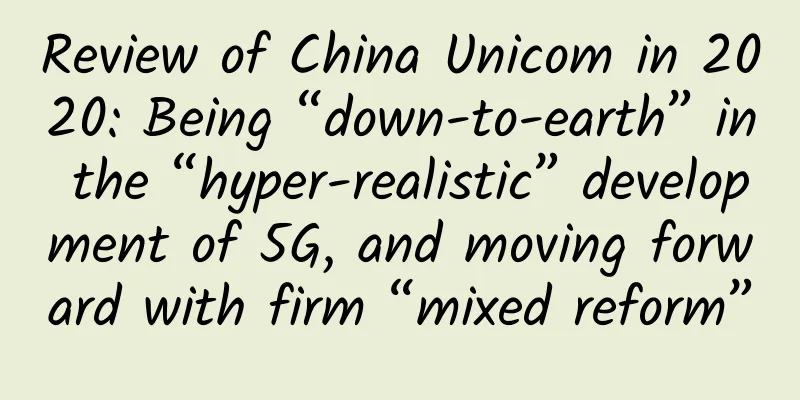Operators’ 5G half-year exam: With the difficult epidemic, high expenditures and low profits, how can they withstand the pressure in the second half of the year?

|
The sudden outbreak of the novel coronavirus pneumonia epidemic has significantly increased the uncertainty of the development of the 5G industry in 2020. The progress of 5G network construction, supply chain and market have all been affected to a certain extent, which has also made the urgency and importance of 5G construction more prominent.
"Carrying the weight" into the second half Operators still face huge pressure Half of 2020 has passed. Driven by the favorable policies of "new infrastructure" and market demand, operators have delivered satisfactory answers to the industry in terms of 5G network construction, 5G technical standards, 5G terminals, and industry applications. According to the latest data from the Ministry of Industry and Information Technology, my country's telecommunications business revenue increased slightly by 2.8% from January to May this year. However, does this mean that the development of 5G by operators in 2020 will be smooth sailing? The reporter believes that the answer is no. In fact, operators continue to face tremendous pressure in the second half of 2020. First, the recurrence of the epidemic in China and the continued uncontrollable epidemic abroad have brought long-term impacts. Although my country was the first to get out of the predicament of the epidemic and the economy has gradually improved, the epidemic has also caused some 5G bidding delays and slowed down 5G network construction in the short term. In addition, the freezing of R16 and R17 standards of the international standards organization 3GPP was postponed due to the epidemic, which also affected the establishment of 5G technical standards to a certain extent. Secondly, the huge expenditure required for 5G construction will continue to bring operating pressure to operators. For operators, the main battlefield in 2020 revolves around 5G. The 5G-related investment of the three major operators totaled 180.3 billion yuan, which has doubled compared with last year. Operators have promised to build 600,000 5G base stations by the end of the year. The continued deployment of 5G networks will make operators face a lot of depreciation and operation and maintenance costs, which will put pressure on their profitability. Finally, the current 5G user penetration rate in my country is not optimistic. Although industry insiders estimate that the number of 5G users in my country has exceeded 100 million based on the operating data released by the three major operators in May, the 5G replacement wave has not arrived due to the lack of promotion of key 5G applications, and the increase in the user penetration rate of 5G packages still depends on the operators' substantial price cuts. "Under pressure" As we enter the second half of 2020, China's 5G construction continues. How can operators withstand the pressure and maintain the construction speed to achieve the commitments made at the beginning of the year? What new measures will be taken in the future that are worthy of operators' focus and continued efforts? Analyzing the recent speeches of experts from the three major operators in public occasions may help us understand the focus of operators' efforts in the second half of the year. Pushing 5G MEC Accelerating 5G network deployment The application of MEC in the 4G era was not satisfactory. Why do operators attach so much importance to the deployment of MEC in the 5G era? First of all, according to Gartner's forecast, the number of devices connected to the network will reach 20.8 billion in 2020, and mobile applications urgently need a more competitive, scalable, secure and intelligent access network. MEC, as a key technology of 5G deterministic network, is the entrance to open network capabilities close to users and applications, and providing network services is the main business of operators. Therefore, the future 5G MEC market of over one trillion will be an important catalyst for the innovation of operators' business models. Secondly, storing Internet content locally based on the MEC platform can save operators about 70% of transmission investment, and 70% of Internet content in the future can be realized in the metropolitan area close to users. What's more, occupying the 5G MEC market can be carried out simultaneously with the construction of 5G networks, which gives operators no reason not to attach great importance to the deployment of 5G MEC. With the development of 5G, the three major operators have accelerated their layout in MEC ecosystem construction, platform development, and application demonstration. Relying on the advantages of cloud-network integration and edge computing platforms, operators have opened their own infrastructure capabilities to industries and applications, which enables business scenarios to be deeply coupled and innovated with network capabilities. However, the application areas of MEC are far more than this, and the exploration of more application scenarios will be the focus of operators in the 5G MEC field in the future. China Telecom is building an open and real network test environment for MEC, including a low-latency and high-bandwidth test environment, to accelerate the innovation of new services and shorten the time to go online without affecting existing network services. China Mobile has established an edge computing laboratory and an edge computing committee, and has carried out pilots at multiple levels with the help of the Sigma platform. It has launched applications and demonstration services with more than 100 leading demonstration companies and promoted the implementation of 91 edge computing demonstration projects. China Unicom has built a MEC business operation center, created multiple incubation bases, and proposed the development goal of building 1,000 edge nodes. It has made breakthroughs in many fields such as MEC smart ports, smart medical care, smart manufacturing, new media, and smart transportation. In a recent speech, Tang Xiongyan, chief scientist of China Unicom Network Technology Research Institute, revealed that in the future, China Unicom will further promote the joint construction and sharing of 5G networks and edge infrastructure. It will not only cooperate with operators, but also work with cloud service providers, network service providers, industrial IT equipment providers, etc. to jointly explore the differences and collaboration of edge computing facilities and services. Accelerate the evolution to 5G SA target network At present, the communications industry chain is looking forward to the mature commercialization of the more powerful 5G SA as soon as possible. SA is the first new generation network that my country has realized from leading design to leading deployment. Therefore, the three major operators are accelerating the evolution to the SA target network. The time is tight, the demand is high, the expectations are high, and the task is heavy. Although the commercial use of 5G SA still faces many challenges, operators are actively seeking opportunities in the challenges. Wei Leping, director of the Science and Technology Committee of China Telecom Group, elaborated on the latest progress of the 5G SA ecosystem in a recent speech. He said that China Telecom has taken the lead in completing the SA end-to-end system function verification and interoperability performance testing, and is accelerating the adaptation of 5G to vertical industries. At the same time, it focuses on industries such as industry, transportation, media, medical care, and education, and is committed to promoting 5G SA high-quality industry applications. Huang Yuhong, deputy director of China Mobile Research Institute, said that China Mobile is determined to take SA as its goal, and will build networks for to B and to C respectively in terms of network architecture to achieve the integration of 4G and 5G. Through the coordination of 700MHz, 2.6GHz and 4.9GHz three frequencies, 700MHz and 2.6GHz for basic coverage, and 4.9GHz for capacity supplement and industry applications, China Mobile aims to build the world's largest and most technologically advanced 5G SA network. Miao Shouye, head of China Unicom's 5G co-construction and sharing working group, said that China Unicom and China Telecom are taking SA as their goal and actively promoting the maturity of SA technology and networks. The two parties strive to achieve commercial use of SA networks by the end of September this year and enhance the 5G network's support capabilities for vertical industry applications. Start the construction of 5G message commercialization platform In April this year, the three major operators jointly released the "5G Message White Paper" and jointly launched the 5G message service. Zhang Yunyong, general manager of China Unicom's product center, said in an interview with reporters at the end of May that 5G messages have upgraded the operator's SMS service through innovative experience. It is currently in the testing phase and is expected to be officially commercialized in the third quarter of this year. Zhuang Renfeng, deputy general manager of China Mobile Internet Company, mentioned in a recent public speech that the three major operators have already started the construction of 5G commercialization platforms. With the strong support of GSMA, 5G messages will be included in the mandatory functions of 5G terminals. After users change to 5G mobile phones, they can conveniently use 5G message services without downloading the client. It is reported that the operator's customized terminals are about to achieve full coverage of the 5G message UP2.4 version. The mainstream Android brands have upgraded to the 5G message UP1.0 version and are actively following up the 5G message UP2.4 version. The rapid advancement of the commercialization of 5G messages will open a new era for China's to B and toC communications. There is no doubt that 5G messages will bring new market opportunities to operators, platform service providers, third-party service providers, and mobile phone manufacturers, creating a situation of industrial reciprocity and multi-party win-win. However, to firmly grasp the opportunity, it is necessary for all parties in the industrial chain to open up and cooperate to jointly establish an ecological environment for sustainable development. The reporter learned that in order to jointly promote the development of the 5G message industry, the three major operators have jointly established the 5G Message Industry Alliance with GSMA, terminal manufacturers, large Internet companies, SDK service providers, aggregation platforms and other relevant partners, and continue to work hard in open cooperation, co-construction and sharing, and coordinated development. Amid the impact of the COVID-19 pandemic, accelerated 5G commercialization, and speed and fee reduction, operators still have a clear direction and a firm goal. The reporter believes that in the second half of 2020, operators will firmly maintain their development pace and complete the annual 5G construction and development goals on time, with quality and quantity. |
>>: Top 10 Internet Acquisitions of 2020
Recommend
edgeNAT February Promotion: 20% off for monthly VPS and 30% off for annual VPS, with optional data centers in Korea, Hong Kong, and the United States
edgeNAT has released a promotion for February thi...
CloudCone 6th Anniversary: $21/year KVM-1GB/30G SSD/1TB/Los Angeles Data Center
CloudCone officially launched its 6th anniversary...
In addition to 404, what other "codes" are there for web pages?
404 Not Found When surfing the Internet, whether ...
Why enterprises should pay close attention to Wi-Fi 7
Industry experts predict that the latest Wi-Fi ve...
5G new scenarios and technologies bring new security threats
Compared with the traditional mobile Internet sce...
Understand RFID technology in one article! 3 types, 6 fields, 7 major advantages
Why can our express deliveries always be accurate...
Deny 5G and believe in Starlink? IQ is a good thing
Not long ago, a foreign artist "made" a...
Huawei wins "2018 GSMA Mobile Industry Outstanding Contribution Award"
At a special ceremony held last night, GSMA prese...
What exactly is HTTP3 that international companies such as Google are beginning to support?
There has been a lot of news about HTTP/3 in rece...
When Wi-Fi 6 enters the home, car and other industry markets, modules become the key players!
"What's the Wi-Fi password here?" I...
Huawei's Hou Jinlong: Grow together with global developers and win together in the new era of computing
On March 27, at the Huawei Developer Conference 2...
Operators launch 5G packages under 100 yuan: including 20G traffic, is it a real price reduction or a routine?
As of now, 5G network has been in place for nearl...
See if you can handle this kind of interview. How does TCP transmit reliably?
Preface Hello everyone, I am Amazing. It is the g...
"5G spreads COVID-19" is a hot topic in India. The Indian Ministry of Telecommunications: Where does our 5G come from?
It is reported that since the epidemic situation ...
What is the difference between a wireless router and an optical modem? This article tells you
When we deploy a WiFi network at home, there are ...









